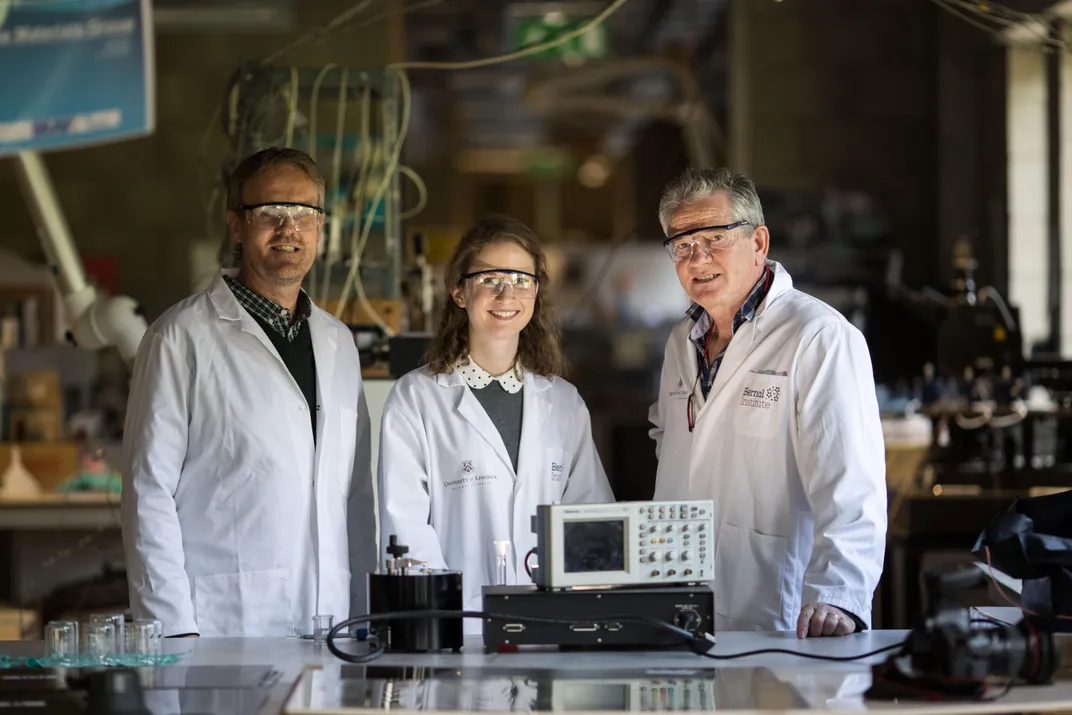Your Tears Can Generate Electricity
A protein found in human tears can create electricity when placed under pressure, potentially paving the way for better biomedical devices
/https://tf-cmsv2-smithsonianmag-media.s3.amazonaws.com/filer/d3/c0/d3c0ee66-cdc4-47c4-88d8-dcd3dda85157/electricity_from_tears.jpg)
Need electricity? Start crying.
OK, not exactly. But Irish scientists have discovered that a protein found in human tears can, when placed under high pressure, produce electricity. They hope this finding could lead to a safer way to power biomedical devices such as pacemakers.
Some materials, including crystals, bone, wood and various proteins, accumulate an electric charge when squeezed. This ability, known as direct piezoelectricity, has applications as varied as guitar pick-ups, biomedical sensors, cell phone vibrators, ocean sonar and cigarette lighters.
The researchers, from the University of Limerick, were interested in seeing if the protein lysozyme, found in tears, saliva, mucus and milk—but far more abundant in chicken eggs—had this property as well. They crystallized the lysozyme using high heat, then put it under pressure and measured its electric output. They were expecting that its piezoelectric coefficient—a measure of its power—would be around 1 picocoulombs per newton, similar to other biomaterials. But the lysozyme actually had a piezoelectric effect of up to 6.5 picocoulombs per newton. The average effect was around 2 picocoulombs per newton, similar to quartz.
“We were quite excited by that,” says Aimee Stapleton, the study’s lead author. The research was published last week in the journal Applied Physics Letters.

The research has a number of potential medical applications. Because lysozyme is biocompatible, it could potentially be a safer way of powering biomedical devices like pacemakers, some of which rely on toxic materials like lead. Lysozyme-generated electricity could also potentially lead to better drug delivery systems, in which lysozyme-powered pumps control a slow release of medication.
Since lysozyme’s main job is to protect against infection, it is a natural antimicrobial.
“This antibacterial property could be useful in biomedical devices,” Stapleton says.
Lysozyme is also abundant and readily available, making it an inexpensive material to work with—it’s commonly used in scientific research and in the food industry as a preservative. But, as Stapleton says, “the applications, they take an awful long time to be realized.”
The next step for Stapleton and her team is to look at another aspect of piezoelectricity, known as the converse (or inverse, or reverse) piezoelectric effect. This is when the application of electricity creates a deformation in the crystal material. If lysozyme shows this effect, it could have a number of potential uses as well.
"I think the performance is still the most important aspect for new material discovery," says Xudong Wang, a professor of materials science and engineering at the University of Wisconsin. "The paper mentioned the piezoelectric coefficient is about the same as quartz. This is kind of low for energy harvesting applications. It will be very interesting to know the theoretical limit of this new material."
Stapleton was studying lysozyme because it is a protein that can be easily crystallized, and having a certain type of crystal structure is a key factor for a material’s piezoelectric potential. Researchers studying piezoelectricity in biological materials have previously looked at more complex materials like cells and tissues. But Stapleton figured it was worthwhile to investigate a simple protein, in the hopes that it could generate some deeper understanding of the process of piezoelectricity.
“We don’t fully understand how [piezoelectricity] works,” she says. “So we thought we’d start with more fundamental building blocks.”
/https://tf-cmsv2-smithsonianmag-media.s3.amazonaws.com/accounts/headshot/matchar.png)
/https://tf-cmsv2-smithsonianmag-media.s3.amazonaws.com/accounts/headshot/matchar.png)